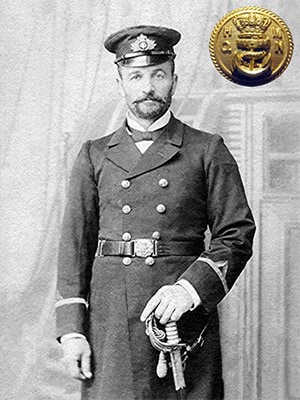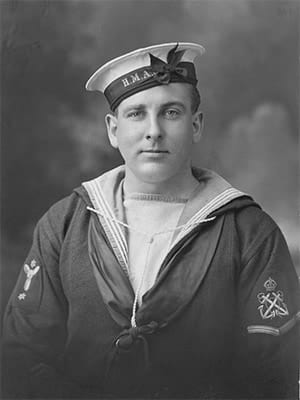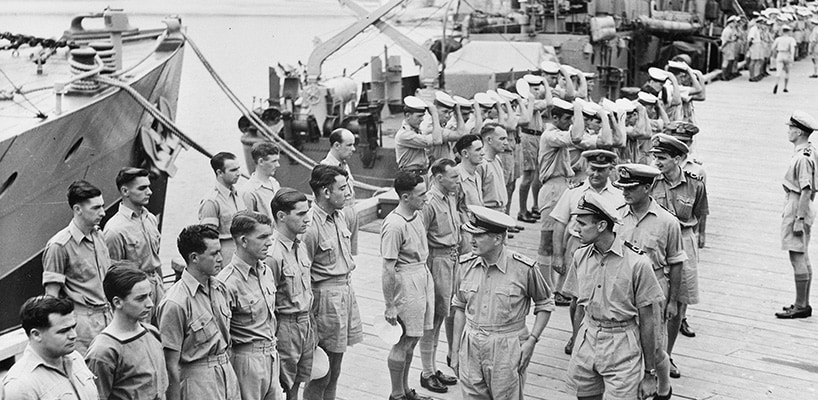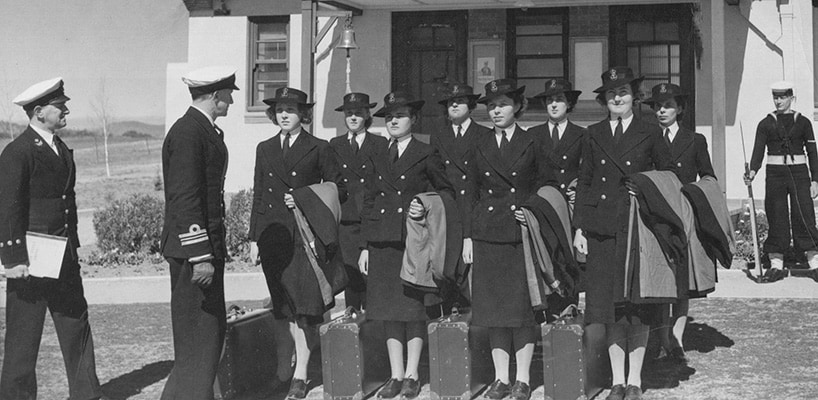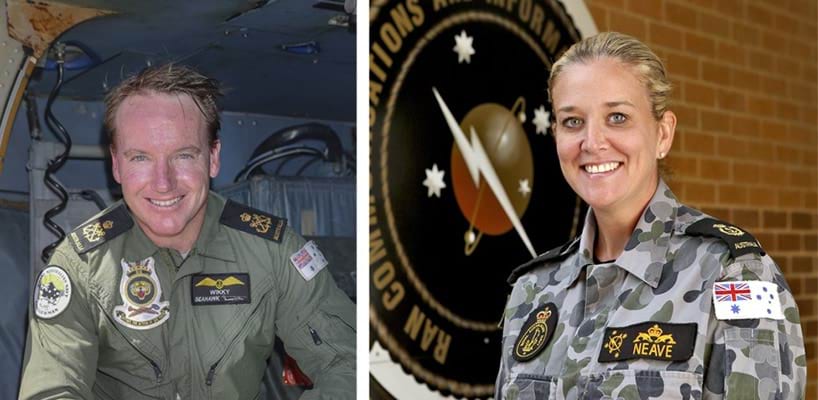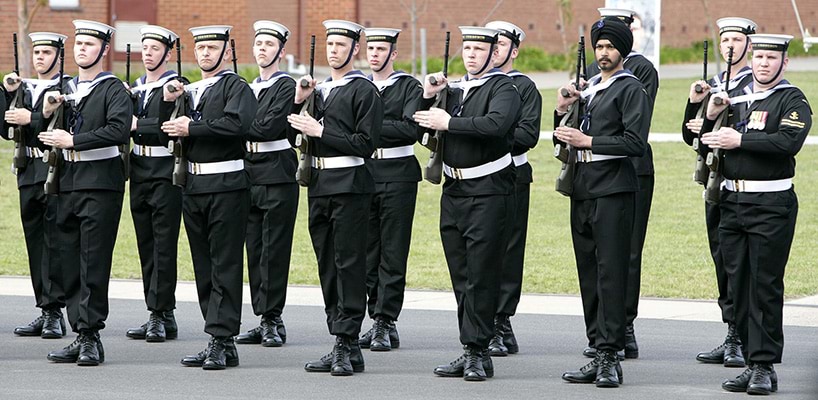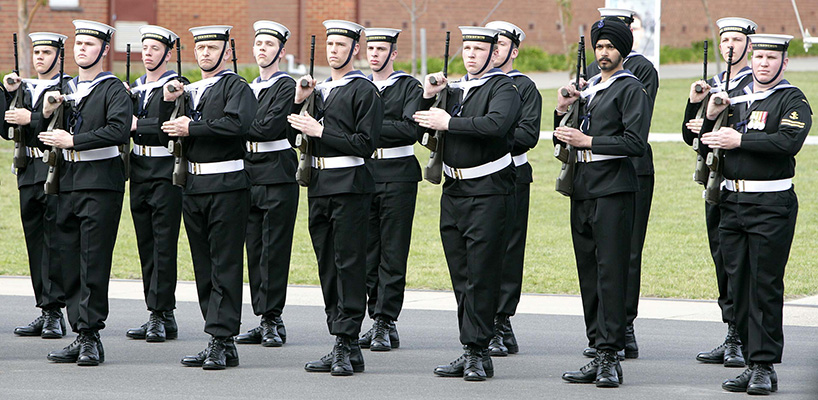
- Service:
- Navy
by John Perryman
The traditional image of a sailor was typically a male, dressed in a seaman’s jumper, blue collar, bell-bottom trousers and wearing a peak-less cap with the name of his ship visible on its front. While this was the case throughout most of the 20th century, it is no longer true of the navy today. Through a process of continuous evolution, influenced by shifting social attitudes, new technologies, wars and even religion, the sailor of today can be found attired in a variety of differing naval uniforms.
Australian naval dress descends directly from that worn by the Royal Navy (RN) in the late 19th century. When the Colonial Naval Defence Act 1865 was passed, permitting the Australian colonies to raise their own naval forces, officers of the RN had been wearing a standardised form of uniform for over one hundred years. In the case of RN sailors, uniform for them was formally established in January 1857. Both officers and sailors of the RN were recognisable the world-over as belonging to the most powerful navy afloat and it
was hardly surprising that the Australian colonies of Victoria, New South Wales, South Australia and Queensland each decided that their infant naval forces should be similarly attired.
The Admiralty, however, concerned about legal aspects surrounding Australia’s new naval forces, was adamant that colonial naval forces should not wear uniforms that might misrepresent the RN. Consequently the colonies adopted RN uniforms, but with minor alterations to rank lace, buttons and cap ribbons to satisfy the Admiralty’s concerns. These minor differences also served to distinguish one colonial naval force from another.
By the early 1880s the uniform that popularised the ‘sailor suit’ had evolved with seamen generally appearing in blue serge or white duck (heavy cotton) versions. On frock coats and jumpers an indigo-dyed jean collar bearing three rows of white tape was worn. Contrary to popular belief the white tape did not commemorate Vice Admiral Lord Nelson’s victories at the Nile, Copenhagen and Trafalgar for even the United States and German Navies made use of this distinction from an early time. Both jumpers and frocks were worn over a white, square cut flannel shirt, the neck of which was also bound with blue tape. A black silk scarf and white lanyard completed the ensemble which was secured with blue or white tape tied in a bow.
Headwear for seamen consisted of either a peak-less round blue or white cloth cap, or a straw sennet hat for use in hot weather. From 1868, all caps and hats worn by seamen had black hat ribbons with gilt wire lettering bearing the name of their ship tied around them.
Chief Petty Officers (CPO) were dressed in double breasted long jackets fastened with gilt buttons, matching trousers and peaked caps of the same design as officers. The caps were
embellished with a gilt wire badge depicting the sovereign’s crown above a rope-fouled Admiralty pattern anchor on a black background. For CPOs of the seaman branch, those qualified to work on deck in ocean going ships, the crown was gold and the anchor silver. For all others, both were gold. Engine room artificers had one further distinction, the background on which their anchor was affixed was purple instead of black. Later, in July 1920, a new cap badge for CPOs was introduced into the RAN. The new badge featured a silver anchor surrounded by a narrow wreath of laurel leaves in gold, surmounted by the Tudor crown. Thereafter, the cap badge previously worn by CPOs was adopted by petty officers.
The late 19th century was a time of great technological change. Sail was giving way to steam and wooden hulled ships were replaced by ironclads equipped with high calibre guns in lieu of cannons. With new technologies came the need for more specialised officers and men to man the ships and a variety of new trades soon appeared throughout the navy.
With these new trades came the introduction of non-substantive rate badges which were worn on the right arm to identify trade specialisations. Some of the earliest of these included gunners, stokers, artisans and signalmen. Badges denoting rank were worn on the left arm along with good conduct chevrons.
Non-executive officers’ specialisations were identified by different coloured distinction cloth worn between the gold rank lace on their sleeves or undress epaulettes. This gave them a colourful appearance, with mechanical engineers adopting purple cloth, paymasters white, surgeons red and electrical engineers green to name just a few. It is from the green, that the term ‘greenie’ originates which remains in use to this day to describe any personnel of the electrical branch. Officers of the medical and dental branches continue the tradition of wearing distinction cloth to this day. Officers of the executive branch have traditionally worn none.
On 1 March 1901, the Australian States transferred their naval forces and all persons ‘employed in their connexion’ to the Federal Government, creating the Commonwealth Naval Forces (CNF).
There were no immediate changes to uniforms and for a period the CNF was a consolidated navy in name only, with each state continuing to wear their former colonial uniforms. It was not until 1904 that new uniform regulations were promulgated. These instructions ordered officers of the CNF to wear the uniform prescribed in the King’s Regulations for officers and men of the RN with only minor modifications to rank lace. This involved the substitution of a triangle in place of the executive curl for seaman officers and the substitution of a gold star for officers of non-executive branches such as paymasters and engineers.
Petty officers, men and boys, adopted the same uniform as that worn in the RN with the exception that cap ribbons were lettered H.M.A.S. [His Majesty’s Australian Ship] followed by the name of their ship. This early reference to use of the letters ‘H.M.A.S’ preceding ship’s names is noteworthy, as it was not until 1911 that King George V officially approved the designation ‘His Majesty’s Australian Ship’.
The granting of the Royal title in 1911 removed any lingering concerns the Admiralty held concerning Australian naval men wearing RN uniform and in 1913 the RAN received approval to adopt the full range of uniforms, badges and insignia of the RN. The only differences that remained between the two were minor changes to buttons and cap ribbons. Also in 1913 was the formation of the Naval Dockyard Police and the first permanent RAN band which paraded dressed in a version of the uniform worn by the Royal Marines Band Service.
In 1914, prior to the outbreak of the First World War, the rank of Lieutenant-Commander was introduced taking its place in the hierarchical structure above lieutenants and below commanders. This saw the familiar ‘half’ stripe introduced between the existing rank-lace worn by Lieutenants. It did not take long for those serving in the lower deck to coin the term ‘two and a half’ to describe officers of that rank.
The following year saw engineering officers granted use of the executive curl on their upper rank stripe and by 1918 the remaining non-executive officers had received similar approval, although the practice of wearing coloured distinction cloth continued for many years.
Not all of the RAN’s personnel went to war wearing navy blue. Members of the Royal Australian Naval Bridging Train, an engineering unit, served at Gallipoli and throughout the Middle East dressed in the olive drab uniform of the 1st Australian Imperial Force (AIF). Its commanding officer, Lieutenant Commander L S Bracegirdle, RAN, saw a need to distinguish between the two forces and designed large, stockless anchor badges to identify them as sailors which were worn in lieu of the army’s ‘Rising Sun’ badges.
Between the end of the Great War and the outbreak of the Second World War a variety of new categories made their appearance including divers and dental mechanics. CPOs uniforms were also altered slightly when approval was given in January 1926 for three large gilt buttons to be added to the cuffs of blue jackets and white tunics. The combination of buttons on the cuffs coupled with the wearing of non-substantive badges on the lapels of the blue jacket became synonymous with the CPO rank.
In March 1928 a new style of RAN button was introduced, comprising a vertical stockless anchor replacing the previously worn ‘lazy’ anchor.
The outbreak of the war with Germany on 3 September 1939 triggered a much more practical approach to fighting dress. At the beginning of the war, many battles were fought in what today would be considered ceremonial uniform. By the war’s end, thousands of sun-tanned Australian officers and sailors could be found throughout the Pacific, with bare chests or clad in khaki open necked shirts, shorts and sandals.
The Second World War also saw the institution of the Women’s Royal Australian Naval Service (WRANS) and the Royal Australian Navy Nursing Service (RANNS). From 1941, Australia’s first female sailors could be found performing a variety of critical jobs ashore dressed in navy blue jackets, skirts and felt fur hats. By the end of the war they too had added a more practical khaki coloured working rig to their kit.
The women’s services were briefly disbanded after the war but in 1951 the WRANS was resurrected. In the same year, post war kit was approved for women that saw the introduction of light blue embroidered badges for ratings and distinctive tricorne hats for officers, CPOs and petty officers. Later the RANNS was also reinstituted and they too adopted their own distinctive uniforms and insignia.
Australia’s reserve forces played a significant role throughout both World Wars serving in theatres the world over. Generally they wore the same uniform as officers and ratings of the permanent forces although officers were easily distinguishable by their waved rank lace which appeared in two different styles. One for the Royal Australian Naval Reserve Seagoing (RANR(S)) and another for officers of the Royal Australian Naval Reserve (RANR) and Royal Australian Navy Volunteer Reserve (RANVR). All were coined to be officers of the ‘wavy navy’ because of their distinctive rank lace.
Chaplains too have been a constant in the RAN since its inception, although it took many years for them to gain approval to wear naval uniform. It was not until 1940 that a peaked cap and distinctive cap badge was approved for wear with a basic form of naval uniform replacing traditional clerical attire.
In 1947, the RAN established a dedicated fleet air arm and soon a proliferation of new aviation trades and specialisations swelled the ranks of the RAN. Flying clothing was introduced, as were a host of new non-substantive rate badges and other items of uniform including black wool berets.
Action working dress, comprising a light blue, long-sleeved shirt and dark blue cotton drill trousers, made its debut in March 1948. This hard wearing working rig was one of the first uniforms to place practicality over appearance. With the outbreak of the Korean War in June 1950 the RAN again found itself on active service. For those who served throughout the conflict it is often remembered for its freezing winter temperatures which saw many personnel resort to wearing warm civilian apparel in conjunction with their uniforms in an effort to keep warm.
On 6 February 1952 King George VI died and Queen Elizabeth II ascended the throne. After Queen Elizabeth II’s coronation in June 1953, the St Edwards Crown was adopted, replacing the Tudor Crown on badges, insignia, buttons and accoutrements of the Commonwealth’s armed forces.
May 1952 saw the establishment of the Clearance Diving (CD) category and from September 1954, the letter ‘C’ was added below the diver’s non-substantive rate badge to indicate the CD qualification.
The 1950s also saw the demise of officer’s distinction cloth (with the exception of the medical and dental branches) and the abandonment of waved lace for officers of the reserve forces. They instead adopted a small letter R which was centred in the loop of the executive curl. This too was later discarded in 1986.
With the 1960s came the beginning of Australia’s involvement in the Vietnam War. Between 1965 and 1972 elements of the RAN undertook continuous service in Vietnam as sea, ashore and in the air. Once again it was the environment in which RAN personnel found themselves serving that influenced changes to uniforms, placing practicality ahead of appearance. Both clearance divers and aviators serving ashore could be found dressed in army style ‘jungle greens’, while in ships on the gun line, officers serving in the RAN’s destroyers adopted the khaki uniforms worn by their counterparts of the US Navy’s Seventh Fleet. The 1960s also saw the RAN band shift out of their Royal Marine styled uniforms and into traditional naval rig.
The 1970s and 1980s saw the introduction of further new non-substantive badges, notably for technical sailors whose badges were adorned with a variety of stars to denote levels of technical expertise. Specialist badges for principle warfare officers were also approved as were navy blue jumpers, known as ‘woolly pullies’, which made their debut in the mid-1980s. With them came the first of the RAN’s soft rank insignia, worn on the shoulders. The disbandment of the WRANS followed and, for the first time, women adopted the traditional uniforms of the sailor as the RAN became one service.
The next major uniform change came with the advent of the first Gulf War. This saw the introduction of grey, fire-retardant combat coveralls which were soon adopted throughout the entire RAN fleet. Around the same time, approval was also given for personnel serving ashore in operational areas to wear army disruptive pattern camouflage uniforms. This was to become standard kit for officers and men of the clearance diving branch
due to the nature of their work. In more recent times, a second variant known as disruptive pattern desert uniform has been introduced into service which, with its sandy coloured tones, is better suited for operations in the Middle East.
In April 1997 sailors’ famous bell-bottom trousers and white flannels were discarded in favour of straight-legged pants and white collared shirts, subtly changing the traditional appearance of the Australian sailor.
Today the practicalities and diversity of naval service coupled with well-being of the RAN’s personnel take precedence over wearing archetypical naval uniform on a day-to-day basis. Traditional naval uniforms are now reserved mainly for ceremonial occasions reminding us of our heritage and reinforcing the traditions of more than a century of service to the nation.
Author:
John Perryman joined the Royal Australian Navy in January 1980 and during a career in communications spanning almost 25 years he attained the rank of Warrant Officer before commissioning as a Lieutenant in 2001.
In November 2004, John left the permanent navy to take up a position in the Naval History Section, Sea Power Centre – Australia. John is the current Director of Strategic & Historical Studies, co-author of Australia’s Navy in Vietnam and author of Kit Muster, a study of the RAN’s uniforms, badges and categories from colonial times to 1953.
Updated
